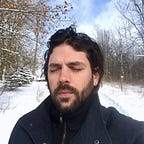A Closer Look at Anthony Goicolea
Backshed, from the series from Summer Camp. © Anthony Goicolea, 2000.
There was a moment at the turn of the century at which digital imaging technologies matured, at which the aesthetics of photo-realism ascended beyond the digital kitsch experiments of the previous decade. The mastery of digital tools spurred a re-evaluation of and insight into the photographic canon, and pictorial genres of the past began to be revisited and explored by photographic artists through the lens of contemporary life. At the vanguard of this new wave of image-makers was Anthony Goicolea.
Recalling the group portraiture of the Dutch Golden Age, Goicolea’s unique method of self-portraiture invokes the intricate and sometimes troubling world of childhood in latency. Genre painting has enjoyed a fruitful history in Western art. From the meek simplicity of Vermeer’s subjects to the vivid and sensual cavorting of Rubens’, the cultural mainstays of genre art are apparent throughout Goicolea’s work. Contemporary digital photo artist Maisie Broadhead’s 2012 work, Coke Break exemplifies how the tradition of genre art continues to hold weight as it moves into realms of self-reference and even satire. Rather than drifting into obscurity, the style has simply continued to evolve through the centuries.
OpenFire, from the series from You and What Army. © Anthony Goicolea, 1999.
______________________
You And What Army (1999–2001) and Summer Camp (2001), possibly Goicolea’s two most praised series, connect the robust sensuality of classic genre paintings to the pithy minutiae of modern digital images. Carefully considered manipulations of light, costume, and post-processing detail allow the artist to cast himself as multiple characters in the same image: unsupervised young boys engaged in enthusiastic and sometimes inscrutable moments of conflict or play. Goicolea’s examinations of adolescence are frank and unflinching: usually portraying the boys spitting, fighting, eating, or kissing. At the same time, the vivid and dreamlike images convey a sense of wonderment at the innocence- and the startling cruelty- of youth. Using these rich, mysterious images to examine the concept of the self as other, Goicolea joined a conversation begun by Cindy Sherman’s Untitled Film Stills (1977–1980). These two series also paved the way for later artists, in particular Julie Blackmon and Kelli Connell, who would each employ similar methods of exploring the vivid mythologies of children and the nature of intimacy, respectively.
Feastlings, from the series You and What Army. © Anthony Goicolea, 2001.
________________________
In You and What Army (1999–2001), Goicolea made his first venture into an artistic style that would continue to define his work for several years. The photographs are mural-sized assemblages of multiple self-portraits, and comprise a narrative centered around a group of pre-teen boys. As in his later work, adults are conspicuously absent from these images, and the children relate freely in hedonistic, bizarre, and vaguely erotic ways. The emphasis on the specificity of individual figures who nevertheless share a common humanity, as well as the rich color, curving forms, and forays into religious metaphor all lend a tone to this series that is distinctly baroque. In his artist’s statement, Goicolea describes this work as an extreme form of “narcissistic fantas[y]” in which multiple selves physically interact to play out various Freudian archetypes. The menagerie of wide-eyed, chubby-cheeked characters frolicking through pastoral tableaux inspires sympathy, yet their strange and occasionally vicious behavior is simultaneously alienating. Overall, the series conjures the layered and complex emotions of pre-pubescence in a striking fashion, through the artist’s unique ability to transform himself into a vibrant and animated pack of middle-school boys.
Boating, from the series Summer Camp. © Anthony Goicolea, 2000.
____________________________
Goicolea carried on in this vein for his next project, Summer Camp (2001). Set in an idyllic North American woodland, the images feature traditional, snapshot-like compositions of young men attending a lakeside campground. While the photographs are decidedly more subtle and lighthearted than those included in You and What Army, they still explore the delicate transition of boyhood to manhood and the idealization of youth. The children, once again exclusively iterations of Goicolea’s physiognomy, pose cheerfully with one another for the camera or are caught in candid, unsophisticated moments. The characters’ simplistic portrayals and cheery garb belie the series’ intimate examination of summer camp as one of the defining moments of childhood passing into maturity. The blonde and brunette pairings of young men, facing slightly away from one another and with eyes fixed on differing distant points, are here presented as a literal divergence of self from self that is precise and tangible.
Wheelbarrel, from the series Summer Camp. © Anthony Goicolea, 2000.
______________________
In later years Goicolea has produced several similar series, although works such as Detention and Underwater take on a much more fantastic and heavily metaphorical tone, veering further into a style perhaps more representative of the Flemish Baroque than the Dutch Golden Age. The examination of the inner lives of children and the deeply narcissistic mythologies of the self remain a prominent theme featured in his recent projects. As an early example of computer-based digital image manipulation, Goicolea’s re-interpretation of the self portrait is a notable departure from traditional forms. In this way, Goicolea releases himself onto the canvas in the form of his inner children: as id, ego, and superego all herded into a single space and instructed to play nice.
Porn, from the series You and What Army. © Anthony Goicolea, 2000.
_______________________________________
Goicolea, Anthony . “You & What Army Statement.” Accessed March 13, 2014. http://www.anthonygoicolea.com/NewAnthonySite/pages/youandwhatstatement.html.
Collins, Neil. “Dutch Baroque Art.” Accessed March 13, 2014. http://www.visual-arts-cork.com/history-of-art/dutch-baroque.htm.
“Cindy Sherman: Self-Portraits of Others.” The Reel Foto(blog), November 01, 2011. Accessed March 13, 2014. http://reelfoto.blogspot.com/2011/11/cindy-sherman-self-portraits-of-others.html
Wikipedia, “Genre art.” Last modified December 27, 2013. Accessed March 13, 2014. http://en.wikipedia.org/wiki/Genre_art.
Images via:
Written by Meghan Maloney with contributions by Gregory Eddi Jones.
Editor’s Note: This feature was originally published on our previous platform, In the In-Between: Journal of Digital Imaging Artists.
___________________________
Stay connected with In the In-Between
Originally published at In the In-Between.
